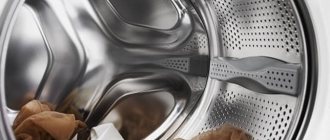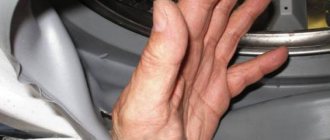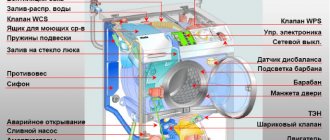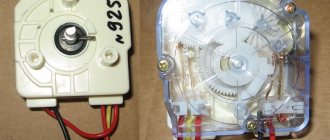In matters of restoring the technical capabilities and performance of household appliances, we are accustomed to relying on service centers. However, not all breakdowns require the intervention of a specialist. Many minor problems can be easily fixed with your own hands.
One typical example is repairing washing machine shock absorbers, which you can do yourself. We will tell you how to dismantle worn parts of the shock absorption system and install new elements. Our recommendations will help you quickly and efficiently restore the operation of your washing machine.
Typical causes of breakdowns
Depending on the settings, the brand of the unit and the functions performed, the washing machine drums make from 700 to 1800 revolutions per minute. Such an impressive load, and even with the application of rotational force, can easily damage contacting parts and weaken components and connections.
If shock absorbers had not been developed to dampen the vibration of the drum and the tank containing it during the spin period, the machine would have to be repaired after each washing “session”. Their purpose is no different from the functions of similar car devices.
Shock-absorbing devices of washing machines perform work equivalent to similar parts of cars. They are designed to dampen the vibrating movements of the tank during the spinning/washing process (+)
Shock absorbers, coupled with suspension springs, eliminate direct contact between the machine’s tank and its metal body, steel and plastic parts. In the form of original supports, they are located under the main rotating part of the equipment, which is fixed in the upper part of the unit by hanging springs.
During operation of the washing machine, the supports and springs are unstable, due to which the drum, rotating at breakneck speed, can slightly shift relative to its resting position.
Those. These devices, performing spring movements, provide the drum with the ability to make the required rotations according to its status, without transferring the load to adjacent parts and assemblies.
The tank of the washing unit is suspended from above using springs, from below it rests on shock absorbers or dampers, which prevent the transmission of vibration from the drum to the body of the machine
The structural components of the washing machine, protected from vibration by shock absorbers, last much longer and are less likely to fail. True, the shock-absorbing devices themselves gradually lose their original strength during the execution of the assigned task.
Worn-out devices may require repair or replacement at an extremely inopportune moment, for example, before an evening wash, the timing of which does not allow calling a technician urgently. Or we will have to wait quite a long time for his arrival. This is where you will need information about the specifics of restoring shock absorbers and their structure.
If there is an urgent need to repair shock absorbers, work on their repair or replacement can be done with your own hands
Call a technician: repair price and ordering
If it is impossible to replace the shock absorbers on your own, it is better to call a technician from a company that provides repairs to washing household appliances. When submitting a request, you must inform the dispatcher about the model of the automatic machine; this information is in the product passport. If dampers have already been purchased, then this should also be mentioned.
The cost of a specialist’s work depends on the company’s price list (you can check it in advance). On average in the capital, replacing one shock absorber in a Samsung washing machine will cost in the capital from 1,300 rubles (excluding the price of the part).
The duration of the technician’s work on average is up to 1.5 hours , unless problems were discovered along the way, which also require the attention of a specialist. Upon completion of the work, a test run of the machine is performed and a guarantee is issued for the repairs performed.
It is not advisable to call specialists based on random advertisements, as there is a risk of falling for scammers. In this case, you may not get quality repairs at all. It is better to contact a trustworthy company that has been in the service provision market for several days.
The device of spring shock absorbers
One of the most common types of shock absorbers for washing equipment has the so-called spring-piston design. To put it in exaggerated terms, it is a metal cylinder with a polymer sleeve at the top. It directs the movement of the rod installed in the shock absorber.
The upper part of the rod is “sharpened” to fit polymer liners and rubber gaskets, with the help of which it is connected to the drum. Attached to the base of the rod is a piston with a gasket heavily impregnated with non-drying lubricant. This lubricant is needed to increase the friction force when the rod and piston move through the cavity of the steel cylinder.
The main structural components of a spring-piston shock absorber include a metal cylinder, closed at the top by a bushing, and a polished rod with a piston
The operation of a spring-piston type shock absorber includes a number of sequentially repeated actions:
- During sudden vibrations, the shock absorber rod is set into linear motion.
- The piston pressed by the rod moves along the cylinder cavity.
- Impregnation prevents the piston from slipping without appropriate force.
- When the pressure is released, the rod returns to its original position.
- When effort arises, everything repeats.
To ensure that the air in the cylinder does not create additional resistance, the piston is perforated. When you press on it, a possible air lock can easily come out through the holes made through it.
The load that appears during rotation of the drum puts pressure on the rod, which in turn pushes the piston fixed at its base along the steel cylinder
Of course, such a mode of operation does not give reason to hope for the eternal preservation of parts rubbing against each other in their original technical condition. At first, just play appears, then wear. Moreover, only one spring support can be damaged, and there are 2 to 4 of them in different modifications of washing units.
To remove the air plug located inside the cylinder, holes are made in it (Fig. on the left). At the top, the shock absorber rod is equipped with a seat for rubber gaskets and polymer inserts, through which it is attached to the washing machine tank
The operating principle of shock absorbers for washing machines of different brands is similar, but there are some design nuances. Their size, angle of inclination, location may differ; not in all models of washing equipment they are supplemented with springs holding the drum on top.
Instead of a pair of suspensions located on top, small springs can be used, connected to a nearby upper counterweight.
In other layout options, the tank, consisting of two parts, is supported by dampers from below instead of shock absorbers. This design type is classic, therefore it is also very worth understanding the structure of these devices. It is possible that this is exactly your case.
The motor in the modification of the washing machine shown in the diagram is mounted at the top. There is no need to disassemble it completely to replace shock absorbers; just remove the side or rear part of the body
DIY repair
Let's find out how to get to the damper. Proceed as follows:
- Let's assume you've already removed the top cover.
- Turn off the water supply and disconnect the inlet hose from the housing. There may be water in it, so prepare a container to drain it in advance.
- Now you need to remove the front panel. To do this, pull out the dispenser tray: press the latch in the center and pull the tray towards you.
- Remove the screws that secure the control panel. Two or three bolts are located behind the tray and on the opposite side.
- Release the plastic latches.
- Take a photo of the location of the wires on the panel and disconnect them or place the panel on top of the CMA body.
- Open the hatch door. Having bent the sealing rubber, use a screwdriver to pry up the metal clamp and remove it.
- Tuck the cuff inside the drum.
- Unscrew the hatch lock bolts (UBL).
- Disconnect the wiring from the locking device and pull it out.
- Unlock the panel latches at the bottom where the drain filter is located and set it aside.
- Unscrew the screws securing the front panel and remove it.
At the bottom of the tank you will notice two dampers. They are usually fastened with plastic rods on top and bolts on the bottom. How to remove the shock absorber from a washing machine:
- Place a nut on the back side of the rod mount to disable the latch.
- Grasp the rod with pliers and pull it towards you.
- Now unscrew the bolt at the bottom.
Some users are wondering: how to check shock absorbers when purchasing? Same as when replacing. Squeeze and unclench the part in your hand: if this is difficult to do, then the product is working properly. If you compress the shock absorber easily, it needs replacement.
Note! Even if only one damper is faulty, both need to be replaced at once.
How can you repair a shock absorber in a washing machine with your own hands? First, pull out the insert that slows down the movement of the rod. If the rod moves easily and quickly, the insert (gasket) is most likely worn out. To replace it:
- Take a 3mm thick belt.
- Measure the length according to the diameter of the hole.
Design features of dampers
Dampers in washing machines are also used in combination with suspension springs, but their structure does not contain elements that are not very strong. In fact, this is also a steel cylinder, although it is not a rod with a piston that moves through its cavity, but simply a piston with holes in the walls to remove excess air.
The damper piston is also equipped with a friction-type gasket. It is made of porous polymer and impregnated with a non-drying lubricant that creates additional friction. There can be two or even more gaskets in the damper, it all depends on the characteristics of the device.
Both the metal cylinder and the damper moving along its cavity are equipped with rubber bushings on the outer edges, with the help of which the shock-absorbing devices are connected to the bottom of the machine and to the tank.
The damper has two main components: a piston equipped with a friction pad, and a steel cylinder in which the piston moves
Dampers are available in two versions:
- Collapsible. To repair this type, most often it is enough to simply replace the pressed gasket.
- Non-separable. Their edges are rolled. Repair of this type consists of replacing the device.
The values of the maximum permissible force possible for a particular shock-absorbing device are indicated on the damper or shock absorber housings. Typically the load varies in the range of 50 - 150 newtons. When operating in the manufacturer-guaranteed mode, washers rarely exceed these limits.
When buying a new shock-absorbing device for replacement, you should not exceed the characteristics indicated on the previous part. If 100 N is indicated on the case, then there is no need to delude yourself that an element with 150 N will last longer; you need to purchase exactly the same one or with similar indicators.
There is a motor attached to the bottom of the tank on the side; it and other components will need to be removed before removal to replace the dampers.
Algorithm
Modern washing machines are disassembled according to one principle. The main difference is in the design of the tank. For example, LG has a collapsible one. Similar ones are installed in Electrolux, AEG, Samsung. To remove the drum, you need to release the mounting screws.
Cars like "Ariston" or "Indesit" have a solid tank. Replacing the entire structure is quite expensive, so experienced craftsmen use several tricks that allow them to replace or lubricate bearings and other parts without updating the entire tank.
After the first stage, access to the shock absorbers/defenders opens. The simplest case is grease abrasion. To restore it, you need to unscrew the parts, extend the rod as much as possible, apply a thick, high-temperature, wear-resistant lubricant to its base and fold and unfold the mechanism several times.
After 10 years of operation, most often the depreciation fails completely. The drum begins to “beat” and make noise during the spin cycle, the machine begins to vibrate and “jump,” and leaks are possible. In such cases, experts recommend replacing the shock absorbers.
Life hack Home craftsmen have found a way to restore defenders and shock absorbers. To do this, you need to remove the rod, as well as the sealing ring-locker. Pour out the “dust” of the gasket and replace it with a piece of leather belt, 2-3 mm thick and approximately 21 mm wide. The section is inserted into the defender body as a ring, with the smooth side facing the body. Next, the gasket together with the rod is treated with a wear-resistant and necessarily viscous lubricant. Machine oil will quickly drain and wear out; such repairs will only last for a couple of months.
Second phase:
Finally the bearing opened. But in order to remove it and lubricate or clean it, you need to free the drum. To do this, place the screw where the flywheel was, and use a hammer to knock the structure out of the “saddle” through the fabric. The pin will come out of the tank and the drum will be separated.
Advice If you have little experience in disassembling washing machines, photograph each significant step and sort the screws so as not to confuse them later. This is especially important when connecting wires.
It's easier to throw away a broken part. The collapsible one should be washed in oil or gasoline, and then filled with semi-liquid lubricant. Most often the bearing is simply replaced.
Important If you want your work not to be in vain, buy replacement high-quality German or Polish bearings that are resistant to moisture and high temperature, vibration and wear.
Often the problem is found in the oil seal - the gasket remains without lubrication and breaks or becomes deformed. The faulty part must be replaced with a new one. When assembling, be sure to apply moisture-resistant grease (it is applied to the inner diameter along which the bearing will slide.
Diagnosis of typical faults
Shock-absorbing devices of washing machines belong to the mechanical part of household equipment. Their repair and replacement do not require fundamental knowledge in the field of electrical or even mechanics. This means that even the intervention of an amateur will not be able to cause serious damage.
Please note that unique technical documentation is issued for each model of washing unit. Service techniques are usually authorized and devices are patented. However, there are methods for repairing shock-absorbing devices that are common to almost all types of washing machines, the specifics of which are worth understanding.
The appearance of typical damage to shock absorbers or dampers will be signaled by a specific noise that occurs during operation of the machine, or too much knocking inside its body.
Symptoms of damage or wear of the shock absorber are unusual noise during washing/spin, strong knocking, excessively active vibration with body distortions
If alarming sounds are detected, their condition should be examined, and for this you need to provide yourself with access to the devices being tested. Depending on the model, for the examination you will need to remove either the top panel, the side panel, or the back panel.
Methods for diagnosing shock absorbers for washing equipment depend on the type of load:
- From the front. If, when applying force to the tank from above, folds form on the sealing collar of the loading hatch, the shock absorbers must be replaced. By the way, you can also notice a couple of folds while the machine is operating with worn-out accessories.
- From vertical. If, when applying force to the tank from above, no resistance is felt, and the tank, after interrupting the pressure, continues to swing like a pendulum, it needs to be repaired.
When carrying out diagnostics with top loading, you must definitely pay attention to how much the tank sags when pressed, if the indicated defect occurs. It would be nice to track the fact of sagging and its conditional value with a full tank load.
The signal to replace the shock absorbers will be the folds on the sealing collar, which often has to be changed no less often than the shock absorbers themselves
It is imperative to check whether there is at least some reserve for the reciprocating movement of the tank of the washing machine being examined. If it sags so that there is simply no room left for it to move during vibration, then a loud knock will occur during washing or spinning. And this is a sure sign of damage to the tank in the near future, and simply imbalance.
In normal technical condition, front-loading washing machines should not have cuff folds at all, regardless of the function being performed. Note that the formation of a single fold on this rubber seal indicates that only one of the shock absorbers is damaged.
If the folds on the cuff of the washer do not indicate damage to the shock absorbers, it means that it is worn out or deformed from the use of substances undesirable for its structure. In this case, the seal should be replaced.
In normally functioning units with a top load, if the shock-absorbing devices are not damaged, after applying force to the tank from above and abruptly interrupting the load, i.e. retracting the hand, the tank should smoothly return to its original place without excessive swinging and vibration.
If the dampers of the washing machine are damaged, then this can be determined by the cuff even with a minimum load of the drum. The presence of two folds in the seal indicates that two devices require repair or replacement
Washing machine shock absorbers: how to remove, change and repair it yourself
Shock absorbers (dampers) are devices included in the design of a washing machine, designed to dampen (dampen) vibrations that occur during washing. If the washing machine has strong vibrations or uncharacteristic knocking noises, then most likely the shock-absorbing devices have failed. Shock absorbers were used in old car models, but modern cars use dampers, they are similar to each other, their only difference is the absence of return springs. Dampers are located at the bottom of the unit under the tank, and springs are installed at the top of the housing to suspend the tank.
Replacing suspension springs
Another shock-absorbing element is steel springs, with the help of which the drum is suspended inside the housing. They are located in the upper part of the machine body. These are quite reliable elements, the replacement of which is required extremely rarely. Sometimes the spring hooks pop out of the eye holes due to vibration; to easily install them in place, just lift the drum.
Not only the quiet operation of the washing machine, but also protection from vibration loads of other elements depends on the reliable operation of the dampers. If shock absorbers break down, it is best to replace them in a service center with a warranty.
Source











